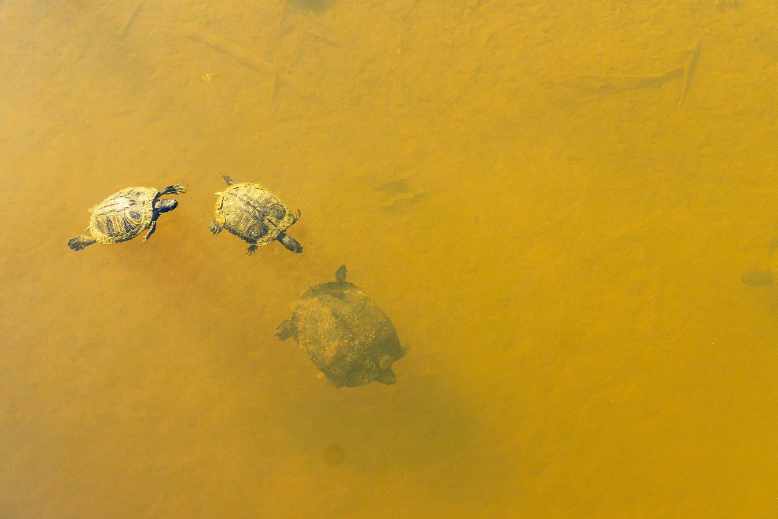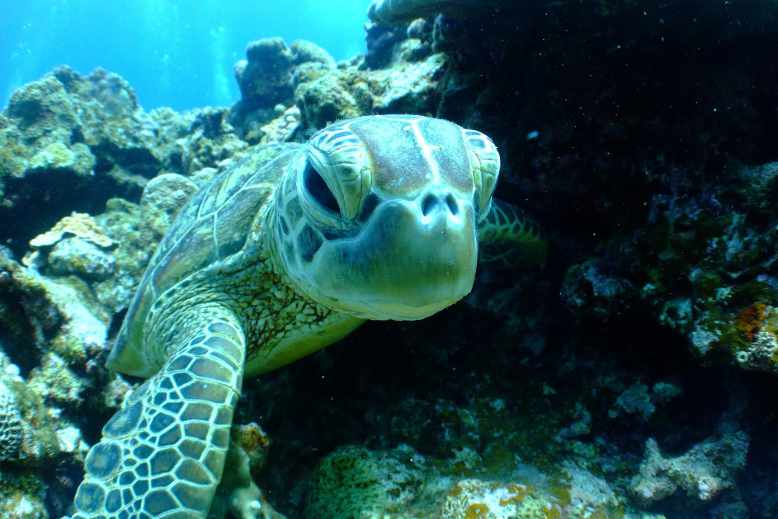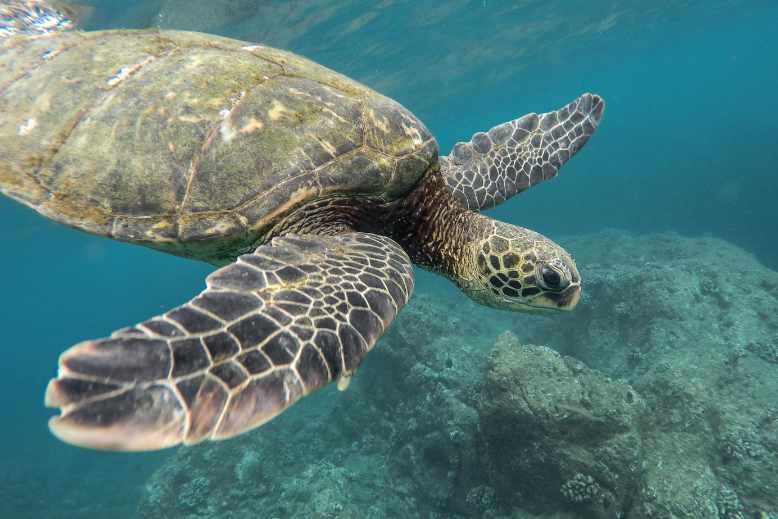Can turtles drown? Can turtles drown? Yes, under unfortunate circumstances, even the swiftest swimmer can drown. In most cases, a turtle drowns because it gets trapped underwater and runs out of breath. Turtles need to come to the surface every few hours to replenish their lungs. If they cannot reach the surface, they will drown.

Turtles are astonishing semi-aquatic creatures who can thrive on land and water equally. Still, they prefer spending most of their life swimming underwater. These shelled creatures can hold their breath for long hours, but they need to reach the water’s surface to replenish their lungs. If a turtle cannot come to the surface, it is likely to drown and die underwater.
With such strong swimming abilities, the question “can turtles drown” might seem silly. But the truth is many turtles die prematurely due to drowning.
In this article, we will learn everything about a turtle’s drowning, including how to tell if a turtle is drowned or sleeping and how to save a drowning turtle. Read on for pointers to learn more.
Can turtles drown?
Turtles, either captive or wild, can stay underwater by holding their breath for pretty long. However, these amphibians don’t have gills and thereby they cannot breathe underwater. Once they get entangled in a fishnet or an underwater bush, they can drown within minutes.
Whether wild or captive, both turtles can down. In the case of sea turtles, drowning is a natural accident that usually occurs during mating season. Sea turtles mate in deep water. Males mount on the female turtles and try to hang onto their shells. This process can get intense for the female turtles because they don’t only have to support their own bodyweight but also their partner’s weight. The mating can take several hours, and for females, it becomes hard to come to the surface to replenish their lungs with the heavyweight on their backs. As a result, female turtles run out of air and drown.
Female turtles can also drown during the mating ritual. Usually, male turtles propose mating by nipping and biting a female’s neck or tail. Some aggressive males start mounting female turtles. When different male turtles try to compete for mating by getting on the female turtle’s back, females get drowned.

To some extent, we humans are also responsible for the death of these majestic creatures. We set up our nets to catch shrimps, fish, and crab in the pond, river, or sea. But when a turtle gets tangled up in the net, he drowns and dies.
Though rare, turtles can drown in captivity as well. Poor aquarium management is responsible for such incidents. Deepwater, loose rocks, and no basking spots are signs of improper enclosure arrangement.
Can sea turtles drown?
Yes. Just like all other amphibians, sea turtles can also drown if they fail to catch a breath at the right time. Contrary to popular belief, sea turtles cannot breathe underwater and coming to the surface is the only way for them to get air. They can hold their breath for 4 to 7 hours while resting, but after this period, they must swim to the surface of the water and breathe in air.
Sea turtles are biologically evolved to adopt this breathing system. Thereby, they don’t drown that often. This species of turtle knows exactly when it is time to replenish those reptilian lungs.
Typically, human-made traps, such as ghost nets, crab catching devices, and fishnets are responsible for a sea turtle’s drowning. When sea turtles get trapped in a net, they panic and try to escape. Their desperate attempts increase the stress level and drain the oxygen storage quickly, leading a turtle to death by drowning. The whole incident doesn’t take more than a few minutes.

Can red eared sliders drown?
Red-eared sliders spend around 75% of their entire lives in the water. Still, they can drown!
In the wild, it is almost rare for this aquatic species to drown. However, in captive situations, poor maintenance by the reptile owners can make a red-eared slider drown.
Improper enclosure management is what makes a red-eared slider turtle down. The pet can get tangled by loose rock or a misplaced plant. Sadly, they cannot hold their breath for more than thirty minutes in an active state and start drowning.

Can box turtles drown?
Being terrestrial turtles, box turtles aren’t great at holding breath and can easily drown in deep water sources.
These beautiful turtles are anything but great swimmers. They prefer spending their lives on the land. They do go to shallow waters but just to cool off their shells and stay hydrated. A box turtle will avoid deep water sources as much as possible to prevent drowning. Therefore, box turtle owners should provide their pets with low-depth water pools to avoid unwanted circumstances.

Can baby turtles drown?
Hatchlings and juveniles have a high risk of drowning. Their tiny bodies have not been developed yet. Plus, they are inexperienced as compared to adult turtles and have weaker bodies. They cannot hold their breath for long hours as their lungs are not that powerful. Baby turtles also don’t understand when is the right time to get back for air. All these factors contribute to a baby turtle’s drowning.
Other than that, a deep-water pool, a basking spot without a ramp, or a super steep and slippery ramp can also be a reason for your pet baby turtle’s drowning.
What makes a turtle drown?
Many man-made and natural factors are to blame for a turtle’s premature death by drowning. Some human factors contributing to this incident are mentioned below
- Deepwater level in the enclosure
- Slippery or steep ramp
- Loose rocks
- No basking docks.
- Fish and crab traps
- Basking spot that’s too high for the turtle to reach
Different natural factors responsible for a turtle’s drowning are:
- Mating in the deep sea
- Not reaching the surface for breathing at the right time.
Turtles often swim in the deep sea to find something edible. Swimming that deep tires out the shelled creatures, and they find it hard to reach the surface.

Sometimes turtles accidentally flip their bodies near water and are unable to get back to their normal position. Accidents like this are also a reason for their drowning.
Regardless of how many reasons we state, this patterned creature basically drowns when it runs out of oxygen. Turtles are not fishes, so they cannot breathe with gills. Instead, they have lungs that need to breathe air.
How long can turtles hold their breath underwater?
Turtles are biologically programmed to hold their breath for 20 minutes to 1 hour. But their breath-holding capabilities mainly depend on the species.
When turtles are active, they can hold their breath for up to 20 to 30 minutes. Sea turtles can hold their breath for more than 30 minutes in an active state.
While resting or sleeping, turtles can stay underwater for 4 to 7 hours without breathing air. However, during hibernation, turtles can sleep underwater for four to seven months. This long hibernation period often confuses many reptile owners and makes them wonder why turtles drown in the water when they can spend months without breathing? How come they don’t drown while hibernating?
Well, the fact is, when a turtle hibernates, his body still needs oxygen but in a relatively small quantity. A hibernating turtle drops his metabolism and other physical activities, thus reducing the overall oxygen requirements. This way, turtles spend months underwater without breathing. They do come to the surface every once in a while, to replenish their lungs but not that often. If they don’t do this, hibernating turtles can also die.
On the other side, an active turtle requires more oxygen. The body of an active turtle can store oxygen for 20 to 30 minutes or 1 hour in some species. After that, the turtle must replenish his lungs with fresh air or else drowning is a must.
Here we have mentioned a few turtle species along with the average time they can stay underwater.
| Turtle Species | Average time underwater |
|---|---|
| Box turtle | 1 to 2 min |
| Snapping turtle | 20 to 30 minutes |
| Map Turtle | 20 to 30 minutes |
| Red Eared Slider Turtle | 20 to 30 minutes |
| Kemps Ridley | 7 to 10 hours |
| Green Sea turtle | 7 to 10 hours |
| Olive ridley | 7 to 10 hours |
| Leatherback Sea Turtle | 7 to 10 hours |
Signs that a turtle is drowned
Now that we know the answer to “can turtles drown,” the next thing we need to understand is how to differentiate a drowned turtle from a sleeping turtle.
Drowning turtles usually move their legs and flippers to and fro to get to the surface.
In most cases, when turtles drown, they become unconscious and enter a state of comatose. Their lungs fill with water, and they begin to lose touch reflexes. On the other hand, sleeping turtles move effortlessly and respond to any sort of touch quickly.

Signs that your drowned turtle is dead
- Dead turtles start to float
If your drowned turtle is dead, his body will start to float on the water surface.
- Live turtles show small moments.
If your turtle is drowned but not dead, he will show some clues of life. You may notice small movements caused by inhaling or exhaling between the neck and front legs or between the back legs and the tail. This movement indicates that your pet’s heart is still pumping and the fellow is alive.
If the inhale or exhale movements are relatively slow, it means that the heart and breathing rate of the pet is dropped after entering into the comatose state.
- Response to touch
Turtles don’t appreciate being touched and prefer to stay alone. Thereby if you wish to know whether your pet is alive or not, touch him. A live turtle will give you an instant reaction.
As a response to your touch, your turtle may draw his legs and head into his shell. Even if a turtle is on his last breaths, he will try to tuck in. So to find out if your turtle is drowned or dead, give him a gentle push.
A dead turtle will not respond to any touch, while a living turtle may tuck into his shell, hiss, or try to bite.
- Pressure to the sensitive area
Some experts suggest applying pressure between the tail and the cloacal region. Dead turtles do not respond to such pressures, but living ones try to protect themselves.
- Bad oder
If a drowned turtle goes unnoticed for several days, it will spread off a foul smell. This smell indicates that your pet no longer exists, and the body is about to decompose.
If still unsure, take your drowned turtle to a vet.
Tips to save a drowning turtle
You can revive a drowning turtle with the following tips.
- Gently remove the turtle from his aquarium without turning it upside down.
- Hold the turtle vertically by keeping his head lower than the tail.
- Place your hands under the pet’s head.
- Delicately pull the neck till it is extended.
- Do not try to give mouth to mouth. Human breathing capability is stronger than that of turtles. The powerful air blow can damage the pet turtle’s internal organs.
- Push down your pet’s lower jaw and try to open his mouth. It will drip the water out. If the water doesn’t come out, rush to the vet.
- Once the water is out of your pet’s mouth, put him on a flat and dry surface.
- Gently pull your pet’s front legs towards you and then push back. Repeat this process with rear legs too. This movement resembles a pumping action and helps the turtle get rid of excess water.
- Finally, take your turtle to the vet for proper treatment.
Final words
Though unfortunate, turtles can drown. This isn’t really common but can happen. So if you find a drowning turtle, try reviving it with proper guidelines and take the turtle to the vet as soon as possible. Your quick actions may save the turtle’s life.




